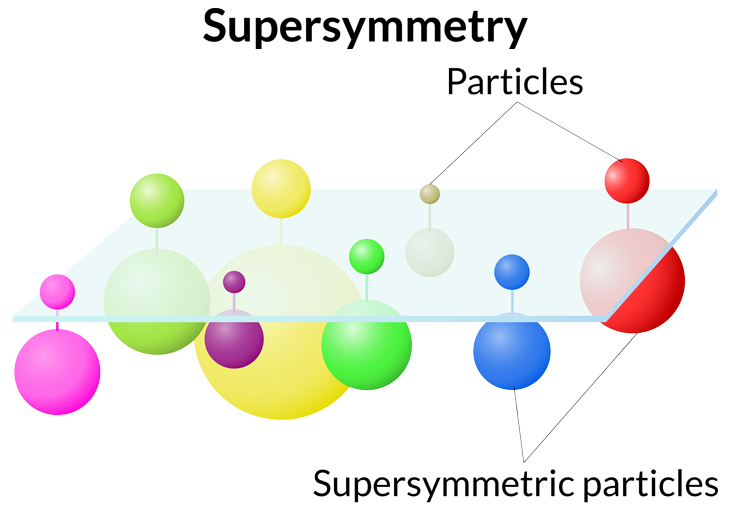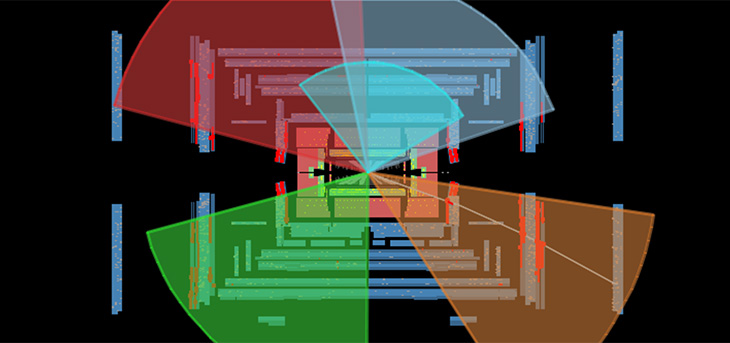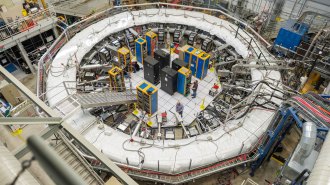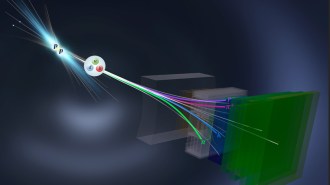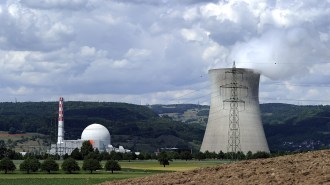Supersymmetry’s absence at LHC puzzles physicists
Lack of new particles suggests need to consider new theories
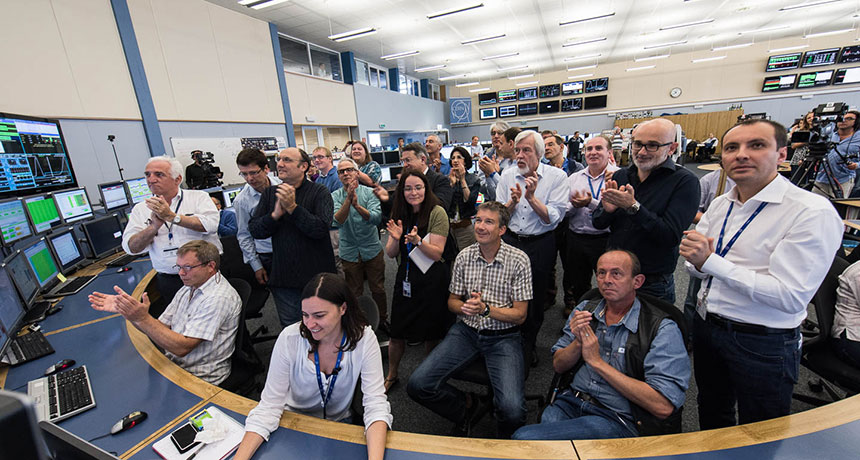
HIGH HOPES Scientists watched from the CERN control room as the LHC particle accelerator first began running at higher energies in June 2015. New data from the LHC has revealed no hints of new particles, despite physicists’ high hopes.
M. Brice/CERN
A beautiful but unproved theory of particle physics is withering in the harsh light of data.
For decades, many particle physicists have devoted themselves to the beloved theory, known as supersymmetry. But it’s beginning to seem that the zoo of new particles that the theory predicts —the heavier cousins of known particles — may live only in physicists’ imaginations. Or if such particles, known as superpartners, do exist, they’re not what physicists expected.
New data from the world’s most powerful particle accelerator — the Large Hadron Collider, now operating at higher energies than ever before — show no traces of superpartners. And so the theory’s most fervent supporters have begun to pay for their overconfidence — in the form of expensive bottles of brandy. On August 22, a group of physicists who wagered that the LHC would quickly confirm the theory settled a 16-year-old bet. In a session at a physics meeting in Copenhagen, theoretical physicist Nima Arkani-Hamed ponied up, presenting a bottle of cognac to physicists who bet that the new particles would be slow to materialize, or might not exist at all.
Whether their pet theories are right or wrong, many theoretical physicists are simply excited that the new LHC data can finally anchor their ideas to reality. “Of course, in the end, nature is going to tell us what’s true,” says theoretical physicist Yonit Hochberg of Cornell University, who spoke on a panel at the meeting.
Supersymmetry is not ruled out by the new data, but if the new particles exist, they must be heavier than scientists expected. “Right now, nature is telling us that if supersymmetry is the right theory, then it doesn’t look exactly like we thought it would,” Hochberg says.
Since June 2015, the LHC, at the European particle physics lab CERN near Geneva, has been smashing protons together at higher energies than ever before: 13 trillion electron volts. Physicists had been eager to see if new particles would pop out at these energies. But the results have agreed overwhelmingly with the standard model, the established theory that describes the known particles and their interactions.
It’s a triumph for the standard model, but a letdown for physicists who hope to expose cracks in that theory. “There is a low-level panic,” says theoretical physicist Matthew Buckley of Rutgers University in Piscataway, N.J. “We had a long time without data, and during that time many theorists thought up very compelling ideas. And those ideas have turned out to be wrong.”
Physicists know that the standard model must break down somewhere. It doesn’t explain why the universe contains more matter than antimatter, and it fails to pinpoint the origins of dark matter and dark energy, which make up 95 percent of the matter and energy in the cosmos.
Even the crowning achievement of the LHC, the discovery of the Higgs boson in 2012 (SN: 7/28/2012, p. 5), hints at the sickness within the standard model. The mass of the Higgs boson, at 125 billion electron volts, is vastly smaller than theory naïvely predicts. That mass, physicists worry, is not “natural” — the factors that contribute to the Higgs mass must be finely tuned to cancel each other out and keep the mass small (SN Online: 10/22/13).
Among the many theories that attempt to fix the standard model’s woes, supersymmetry is the most celebrated. “Supersymmetry was this dominant paradigm for 30 years because it was so beautiful, and it was so perfect,” says theoretical physicist Nathaniel Craig of the University of California, Santa Barbara. But supersymmetry is becoming less appealing as the LHC collects more collisions with no signs of superpartners.
Supersymmetry solves three major problems in physics: It explains why the Higgs is so light; it provides a particle that serves as dark matter; and it implies that the three forces of the standard model (electromagnetism and the weak and strong nuclear forces) unite into one at high energies.
If a simple version of supersymmetry is correct, the LHC probably should have detected superpartners already. As the LHC rules out such particles at ever-higher masses, retaining the appealing properties of supersymmetry requires increasingly convoluted theoretical contortions, stripping the idea of some of the elegance that first persuaded scientists to embrace it.
Story continues after graphic
“If supersymmetry exists, it is not my parents’ supersymmetry,” says Buckley. “That kind of means it can’t be the most compelling version.”
Still, many physicists are adopting an attitude of “keep calm and carry on.” They aren’t giving up hope that evidence for the theory — or other new particle physics phenomena — will show up soon. “I am not yet particularly worried,” says theoretical physicist Carlos Wagner of the University of Chicago. “I think it’s too early. We just started this process.” The LHC has delivered only 1 percent of the data it will collect over its lifetime. Hopes of quickly finding new phenomena were too optimistic, Wagner says.
Experimental physicists, too, maintain that there is plenty of room for new discoveries. But it could take years to uncover them. “I would be very, very happy if we were able to find some new phenomena, some new state of matter, within the first two or three years” of running the LHC at its boosted energy, Tiziano Camporesi of the LHC’s CMS experiment said during a news conference at the International Conference on High Energy Physics, held in Chicago in August. “That would mean that nature has been kind to us.”
But other LHC scientists admit they had expected new discoveries by now. “The fact that we haven’t seen something, I think, is in general quite surprising to the community,” said Guy Wilkinson, spokesperson for the LHCb experiment. “This isn’t a failure — this is perhaps telling us something.” The lack of new particles forces theoretical physicists to consider new explanations for the mass of the Higgs. To be consistent with data, those explanations can’t create new particles the LHC should already have seen.
Some physicists — particularly those of the younger generations — are ready to move on to new ideas. “I’m personally not attached to supersymmetry,” says David Kaplan of Johns Hopkins University. Kaplan and colleagues recently proposed the “relaxion” hypothesis, which allows the Higgs mass to change — or relax — as the universe evolves. Under this theory, the Higgs mass gets stuck at a small value, never reaching the high mass otherwise predicted.
Another idea, which Craig favors, is a family of theories by the name of “neutral naturalness.” Like supersymmetry, this idea proposes symmetries of nature that solve the problem of the Higgs mass, but it doesn’t predict new particles that should have been seen at the LHC. “The theories, they’re not as beautiful as just simple supersymmetry, but they’re motivated by data,” Craig says.
One particularly controversial idea is the multiverse hypothesis. There may be innumerable other universes, with different Higgs masses in each. Perhaps humans observe such a light Higgs because a small mass is necessary for heavy elements like carbon to be produced in stars. People might live in a universe with a small Higgs because it’s the only type of universe life can exist in.
It’s possible that physicists’ fears will be realized — the LHC could deliver the Higgs boson and nothing else. Such a result would leave theoretical physicists with few clues to work with. Still, says Hochberg, “if that’s the case, we’ll still be learning something very deep about nature.”
Editor’s note: This story was updated September 9, 2016, to give the preferred affiliation of Carlos Wagner.
